david_kcmo
Active Member
Just looking to keep my toes toasty on s40. Fairings may be the answer.
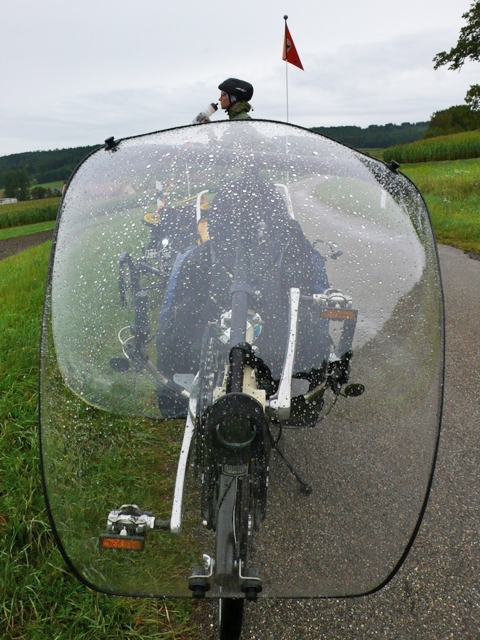

 forum.cruzbike.com
forum.cruzbike.com
Where are you located. Would you be open to my coming by to look at this in person? (I'm out in Woodinville).A few comments on stuff said above:
I have more than 10k miles of riding a CB with a fairing (Q45, and before that a QX100 ... and before that some more thousands on a Rans Rocket and a BikeE). It's my much-used raingear as a year round Seattle commuter.
Kind of a necessity in the winter in these parts. Feet are dry. Hands are dry. Drivetrain is dry. Warmer, too. It's huge. Yes, if it rains really hard I get wet, but for our usual drizzly rain and a half hour commute, no.
Frankly, the ability to mount a fairing is why I ride recumbents.
See photo at:

Cruzbike PPE. Two versions
Two Cruzbikes are closer than 6 feet, but since one has a mask and the other a face shield, they're probably safe enough. @Tortue rode over for a raingear comparison today. His mask is light, elegantly made with 3-d printed connecting parts, and gives him great visibility in traffic. Mine has...forum.cruzbike.com
Mine is the clear polycarbonate one on the right, home-built. I've also ridden Cruzbikes and the other recumbents with commercial Zzipper and Windwrap fairings, also thousands of miles.
1) People who apparently haven't done it speculate about fairings such as these "If a cross wind were to catch the fairing it could steer you right off the road".
Nope. When Seattle rains it's usually windy too. Being in a gap between two large mountain ranges commonly produces 20mph southerly winds with higher gusts. I ride normally in these, and my usual commute has about a mile completely exposed to the crosswind. Never have felt in any danger of being blown off the road. Yes, I pay more attention in very gusty conditions, but that applies to any rider on any bike.
I think the reason for this is that the fairing does not obstruct crosswinds that blow right through, unlike a wheel disk that would catch crosswinds. (Or a full fairing).
In real world conditions this just is not a problem.
2) it is true that my fairing adds weight to the front end (about 4lb). I notice it when riding slowly. Probably a new rider would find it harder to control. And it's dead weight going uphill (350 ft climb going home at night). Less than desirable, but just something to adjust to if you need to ride in the rain, and being dry makes it worth it.
3) The big difference between my fairing and the commercial ones, and the reason I built it (I have a comparable Zzipper) is that the blown upward curve of the Zzipper blocks my forward view. Mine is built so the straight line of the top is precisely along my line of sight. I want to see that pothole or patch of gravel before I hit it.
My fairing is built to just clear my hands, knees and feet. A straight line does that. Then it curves down in front.
However, my angular fairing with its blunt front doesn't give much if any reduction of drag. The Zzipper definitely does, maybe 5% or so speed increase on downhill roll tests.
If you live in a rainy climate a fairing is the shit, and the warmth and dryness makes the awkwardness of the weight in front well worth it.
I have a 2021 S40 that I built up from the frame. I'm only at around 4-500km total on it - the longest ride a pretty flat100km. I just switched my indoor setup to an old Burley recumbent, which I'm hoping will help with getting my legs more used to a 'bent.Sure. I live in NE Seattle.
This should be possible on a weekend soon.
But I'm going on a work trip through Thanksgiving weekend, so not till after that.
Message me again in early December and we should be able to work something out.
What do you ride?
Could I get some more details on this fairing? I would love to experiment with something like this. I ride most days and spend a lot of time looking down that boom and slider thinking that a fairing would be awesome, especially since it is cold out now.I attached a bubble fairing on my V20 as shown in the photo, but I didn’t like it a lot. It blocked the wind, but didn’t make me any faster. It was not good in the dark due to glare. But it was okay in daylight. I stopped using it.
I will get you some details soon. I might also want to sell mine. I built an adapter for my V20. But if I kept the fairing, I would use it on my fat trike. More to follow.Could I get some more details on this fairing? I would love to experiment with something like this. I ride most days and spend a lot of time looking down that boom and slider thinking that a fairing would be awesome, especially since it is cold out now.
Specifically, did you make the fairing? If not, did you buy it and what type of bike was it made for?
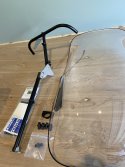
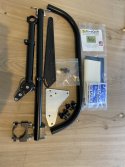
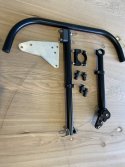

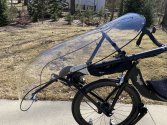
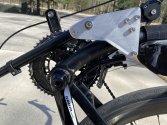
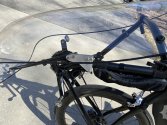

Awesome, curious as to what software was used to design the fairing, and what process was used to shape the foam. Great job! I have always thought my v20 would make a great streamliner.These show the foam plug halves before hard coat and some smoothing, and initial side view illustration of fairing position to V20. Too cold at the moment to do any epoxy layup work. Estimate of hinge location at black angled line. Will start to develop support and stiffening after right half shell (~3 mm thick) is completed.
I used SolidWorks for the modeling. Using surfaces first, then converting them to solids is easiest and gives the most design flexibility. There is a CAD program called OnShape that may be similar but has a free version. Actually Powerpoint or similar presentation programs are useful for overlay and scaling purposes. Accuracy is about +/-.5" (13mm) for this application in Powerpoint. I did a test wet carbon/epoxy layup on a rounded block of foam and was very happy with the finish after all sanding, polishing, and two coats of car wax left it silky smooth. I followed this video suggested method:Awesome, curious as to what software was used to design the fairing, and what process was used to shape the foam. Great job! I have always thought my v20 would make a great streamliner.
